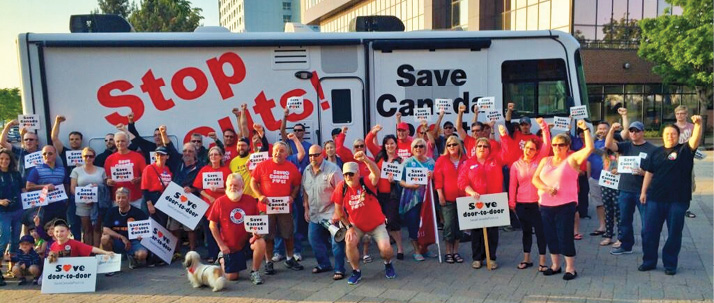May 1, 2016
Door-to-Door Success in Canada
(This article first appeared in the May-June 2016 issue of The American Postal Worker magazine.)
Communities across Canada are facing cutbacks in mail service, much like we are experiencing in the U.S., and like our union and A Grand Alliance to Save Our Public Postal Service, the Canadian Union of Postal Workers (CUPW) and its allies are fighting back.

In a move that would have eliminated up to 8,000 union jobs and forced customers to pick up their mail at a cluster mailbox, Canada Post announced in 2013 a phase-out of door-to-door delivery in urban areas.
CUPW and its allies employed a number of creative tactics to inform and engage the public. Postal workers and community residents have teamed up to canvass neighborhoods, speak at city council meetings, sign petitions, phone bank, and caravan across the country. Some built “guerilla gardens” on top of the cluster box sites, preventing new mailboxes from being installed.
CUPW’s campaign, Save Canada Post, made door-to-door delivery an issue in Canada’s election and got results. The new government stopped (at least temporarily) all new cluster box installations and has promised a thorough review of Canada Post. Save Canada Post is also calling for restoration of door-to-door delivery where it was cut.
Canadians Look to the Future
Fresh off their victory, CUPW launched a major initiative to explore how Canada Post can become a hub of the “Next Economy.” The campaign, “Delivering Community Power,” launched on Feb. 29, calls for “innovative ideas for a different kind of postal office – one that might fuel a greener economy.”
Some ideas include converting the postal fleet to electric vehicles, and an expansion of Letter Carrier duties to include checking up on seniors and those with limited mobility and delivering fresh produce. Post offices could offer charging stations for electric cars, put solar panels on roofs, and establish community-owned energy cooperatives that could be funded with loans from the proposed postal bank and create new jobs.
“Our post offices can become centers of community care and economic development, while bringing emissions down,” said environmentalist Naomi Klein.
“Cuts, privatization and fee hikes are backward notions that increase inequality and undermine public services. We’re looking at the future,” said CUPW President Mike Palecek.
The coalition is calling for postal banking as a means of financial inclusion and green investment – a “platform for promoting, financing, supporting and coordinating a green energy revolution.”
“Now is the time to do more than protect the status quo: we need to have the courage to reimagine it,” said Klein, “Which is precisely what Canada’s postal workers are doing.”
“We should take inspiration from the terrific work of our sisters and brothers in Canada,” said APWU President Mark Dimondstein. “Much like our own campaign, A Grand Alliance to Save Our Public Postal Service, the CUPW and Delivering Community Power are blazing a path for a vibrant public Postal Service for generations to come.”
For more on the door-to-door campaign, check out “Grassroots Action Delivers a Win for Door-to-Door Mail” in the March 2016 issue of Labor Notes at www.labornotes.org and www.savecanadapost.ca. For more information about Delivering Community Power, visit www.deliveringcommunitypower.ca or www.cupw.ca.



